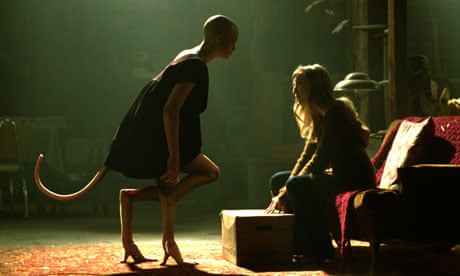In Splice there are a couple of genetically engineered creatures called Fred and Ginger, which look a bit like penises. I daresay if they were chasing you down a dark alley it might be alarming, but in appearance they're not so much frightening as a bit yucky. For something to truly give you the creeps, it needs to have some hint of human physiognomy. There's another creature in Splice like that. Her name is Dren (try spelling it backwards) and she's a lot more disturbing than the penises. Her face and torso are more than vaguely human, even aesthetically beautiful, but she has legs like a wading bird, and a tail, and that's just not right.
A lot of movie monsters are simply giant lizards or insects or arachnids, often the results of atomic tinkering, such as Godzilla or Mothra or the ants in Them! You would have good reason to avoid them – they'd probably try to squash or eat you – but they don't make your flesh crawl. There's something more fundamentally upsetting about the dog with the human face in the 1978 remake of Invasion of the Body Snatchers, or the fly with the tiny human head screaming "Help meee!" in The Fly (1958).
These horrific mash-ups remind me of Max Ernst's surreal collage novel <a href="http://www.musee-orsay.fr/index.php?id=649&L=&tx_ttnews[tt_news]=20484&no_cache=1&L=1" title="Une <00ad>Semaine de Bonté">Une Semaine de Bonté, in which stalking human figures have birds' heads or bats' wings. And the primal programming evidently harks way back to before the dawn of cinema, because the apocalyptic visions of Hieronymus Bosch are teeming with fish-faced demons and bird-headed imps. Animal-human hybrids are nothing less than glimpses of hell.
The mother of all genetic-splicing movies is Island of Lost Souls (1932), based on HG Wells's The Island of Dr Moreau. Charles Laughton, simultaneously underplaying and overacting in one of his most gloriously arrogant performances, fuses man and animal in the House of Pain to create a race of hairy hybrids ("Strange-looking natives you have here," remarks the unsuspecting hero) and says things such as, "Do you know what it means to feel like God?", echoing Baron Frankenstein's, "Now I know what it feels like to be God!".
Such presumptuousness, even on the part of a fictional mad scientist, was enough to get the film frowned on in religious circles, which furthermore would have been unlikely to look kindly on suggestions that the boundary between man and animal was so flimsy. Island of Lost Souls was banned in the UK for 25 years on the grounds that it was against nature, to which Elsa Lanchester (Laughton's wife) riposted: "Of course it's against nature. So's Mickey Mouse." The joke's on her, though, since I've always found Mickey Mouse a bit creepy too. It's a mouse's head on a humanoid body, for Christ's sake! Wearing white gloves!
Talking of Mauschwitz (a popular derogatory nickname for Disney), mad genetic science can also prompt uncomfortable thoughts of Nazi-style eugenics. Man-made monsters and their creators often seem obsessed with sex as well, which raises the spectre of that classic Hollywood bugbear, miscegenation. Dr Moreau is indecently eager to see if his panther-woman, Lota, can mate with a human male. Poor Lota doesn't get to first base, though her feline origins are betrayed only by long fingernails that wouldn't look out of place among the manicured claws in Showgirls.
The public's Barnum and Baileyesque appetite for surgically engineered freaks of nature is still being fed. Latest exhibit is The Human Centipede, in which a mad surgeon splices together the gastric systems of three luckless victims, though the centipede element is more metaphorical than arthropod. But the spectre Splice evokes for me – more than eugenics, playing God or cruelty to human-animal hybrids – is that of cosmetic surgery. From certain angles, Dren's wide-set eyes are chillingly reminiscent of certain female actors who have subjected themselves to one facelift too many. Who needs Dr Moreau to rustle up a monster when women are transforming themselves into unnatural-looking creatures of their own free will?
